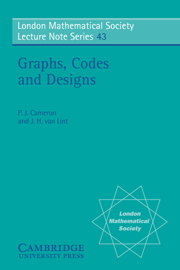Book contents
- Frontmatter
- Contents
- Preface
- 1 A brief introduction to design theory
- 2 Strongly regular graphs
- 3 Quasi-symmetric designs
- 4 Partial geometries
- 5 Strongly regular graphs with no triangles
- 6 Polarities of designs
- 7 Extensions of graphs
- 8 1-factorisations of K6
- 9 Codes
- 10 Cyclic codes
- 11 Threshold decoding
- 12 Finite geometries and codes
- 13 Self-orthogonal codes, designs and projective planes
- 14 Quadratic residue codes
- 15 Symmetry codes over GF(3)
- 16 Nearly perfect binary codes and uniformly packed codes
- 17 Association schemes
- References
- Index
5 - Strongly regular graphs with no triangles
Published online by Cambridge University Press: 16 March 2010
- Frontmatter
- Contents
- Preface
- 1 A brief introduction to design theory
- 2 Strongly regular graphs
- 3 Quasi-symmetric designs
- 4 Partial geometries
- 5 Strongly regular graphs with no triangles
- 6 Polarities of designs
- 7 Extensions of graphs
- 8 1-factorisations of K6
- 9 Codes
- 10 Cyclic codes
- 11 Threshold decoding
- 12 Finite geometries and codes
- 13 Self-orthogonal codes, designs and projective planes
- 14 Quadratic residue codes
- 15 Symmetry codes over GF(3)
- 16 Nearly perfect binary codes and uniformly packed codes
- 17 Association schemes
- References
- Index
Summary
In a graph, a path is a sequence of vertices in which consecutive vertices are adjacent, and a circuit is a path with initial and terminal point equal. A graph is connected if any two vertices lie in a path. The function d defined by d(p, q) = length of the shortest path containing p and q, is a metric in a connected graph; the diameter of the graph is the largest value assumed by d. The girth of a graph is the length of the shortest circuit which contains no repeated edges, provided such a circuit exists.
For strongly regular graphs, the connectedness, diameter and girth are simply determined by the parameters. Γ is connected with diameter 2 if d > 0, and is disconnected if d = 0. Γ has a girth provided a > 1; the girth is 3 if c > 0, 4 if c = 0 and d > 1, and 5 if c = 0, d = 1.
It is easy to see that a graph with diameter 2 and maximal valency a has at most a2 + 1 vertices; and a graph with girth 5 and minimal valency a has at least a2 + 1 vertices. Equality holds in either case if and only if the graph is strongly regular with c = 0, d = 1. Such a graph is called a Moore graph with diameter 2. It is worth noting that analogous bounds exist for larger values of diameter and girth, but recently Bannai and Ito[11]and Damerell [35] have shown that they are attained only by graphs consisting of a single circuit.
- Type
- Chapter
- Information
- Graphs, Codes and Designs , pp. 37 - 44Publisher: Cambridge University PressPrint publication year: 1980
- 1
- Cited by

